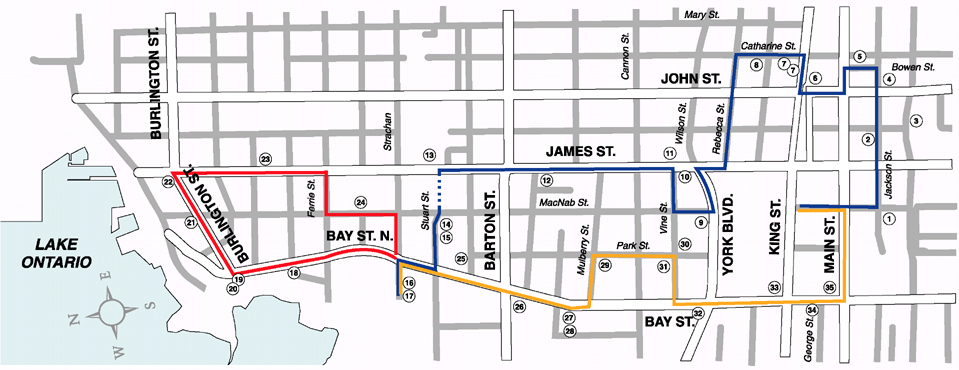MADE IN HAMILTON
19TH CENTURY
INDUSTRIAL TRAIL
![[Industrial Trail Logo]](logo.jpg)
About
This Tour
Come learn about Hamilton's 19th century Industrial Revolution by visiting
the sites of some of the city's first factories and workshops. Let this site
be your guide as you walk the narrow corridor between the harbour and downtown,
where the city's first round of industrialization took place.
How to
use this Site
There is a map below. You may click on the individually numbered locations
on the map, or click on the name corresponding to each number in the ordered
list below.
MADE
IN HAMILTON 19TH CENTURY INDUSTRIAL TRAIL
ROUTE MAP


INTRODUCTION
 In
the second half of the 19th century, Hamilton was transformed from
a commercial centre with a sprinkling of small artisan shops into Canada's
pre-eminent industrial city. These changes did not occur overnight. The city's
first round of industrialization was an uneven process that took decades to
unfold.
In
the second half of the 19th century, Hamilton was transformed from
a commercial centre with a sprinkling of small artisan shops into Canada's
pre-eminent industrial city. These changes did not occur overnight. The city's
first round of industrialization was an uneven process that took decades to
unfold.
This
tour tells the story of the making of the 19th century industrial city.
Small
manufacturers appeared in Hamilton as early as the 1830s, attracted by the
city's extensive hinterland markets, stretching from London to Guelph. The
opening of a canal through the sand bar separating Lake Ontario from Burlington
Bay in 1827 put Hamilton in an advantageous position at the head of Lake Ontario,
giving access to raw materials and technology from the larger manufacturing
centres to the east along the St. Lawrence and Erie canal systems.
 By
the 1840s, the city had developed a reputation as a regional metal centre.
Its fledgling foundries turned out stoves, farming equipment and other necessities
for settlers on the agricultural frontier. Production was done mostly in small
shops by artisans using traditional handicraft techniques.
By
the 1840s, the city had developed a reputation as a regional metal centre.
Its fledgling foundries turned out stoves, farming equipment and other necessities
for settlers on the agricultural frontier. Production was done mostly in small
shops by artisans using traditional handicraft techniques.


 But
skilled work survived. Craftsmen in many Hamilton workplaces maintained a
high degree of shop floor control throughout the 19th century. Their craft
unions fought hard to preserve workplace traditions. Hamilton became a union
town. Workers from different crafts united at different times to voice complaints
about the common injustices they were experiencing under the new industrial
system. Canada's first labour council was formed here in 1864. Hamilton workers
joined together to fight for the nine-hour day in 1872.
But
skilled work survived. Craftsmen in many Hamilton workplaces maintained a
high degree of shop floor control throughout the 19th century. Their craft
unions fought hard to preserve workplace traditions. Hamilton became a union
town. Workers from different crafts united at different times to voice complaints
about the common injustices they were experiencing under the new industrial
system. Canada's first labour council was formed here in 1864. Hamilton workers
joined together to fight for the nine-hour day in 1872.
